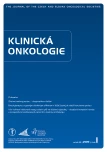Effective Immunotherapy of Glioblastoma in an Adolescent with Constitutional Mismatch Repair-Deficiency Syndrome
Authors:
Z. Pavelka 1; K. Zitterbart 1; H. Nosková 1,2; V. Bajčiová 1; O. Slabý 2; J. Štěrba 1
Authors‘ workplace:
Klinika dětské onkologie LF MU a FN Brno
1; CEITEC – Středoevropský technologický institut, Masarykova univerzita, Brno
2
Published in:
Klin Onkol 2019; 32(1): 70-74
Category:
Case Report
doi:
https://doi.org/10.14735/amko201970
Overview
Background:
Individuals with constitutional mismatch repair-deficiency syndrome (CMMR-D) are characterised by early occurrence of colon cancer, haematological malignancies, and brain tumors (malignant gliomas, high-grade gliomas) in childhood, adolescence, and early adulthood. High mutational tumor burden is typical of glioblastoma in CMMR-D patients and could be a reason why this type of glioblastoma responds well to immunotherapies, including those that employ checkpoint inhibitors.
Observation:
We describe a case of an adolescent with CMMR-D that had been genetically proven by whole exome sequencing (c.2T>A/p.M1K and c.2521delT/p.W841fs PMS2 gene mutation). The patient presented successively with colon cancer and glioblastoma with a high mutational burden. The individualized glioblastoma therapy was based on the biological tumor profile and included immunotherapy with a combination of vaccination with autologous dendritic cells producing IL-12 and nivolumab, in addition to radiotherapy with metronomic temozolomide. The patient is still alive 21 months after the initial glioblastoma diagnosis and shows a complete therapeutic response documented by repeated magnetic resonance examinations.
Conclusion:
Individuals with CMMR-D should be regularly examined using established algorithms. Whole body magnetic resonance imaging can play a key role, because it enables the early diagnosis of malignancy during the asymptomatic period. Malignancies in CMMR-D patients usually exhibit a hypermutated genotype and respond to immunotherapy. Conventional glioblastoma therapy is only palliative. Patients can benefit from an individualized therapeutic plan based on the tumor biological profile. Extensive molecular analysis of the tumor tissue is necessary.
Key words
hereditary cancer predisposition syndromes – glioblastoma – whole exome sequencing – immunotherapy – vaccines – checkpoint inhibitors
This study was supported by the research project of the Czech Ministry of Health AZV 16-33209A (Next generation sequencing and express profiling as diagnostic tools for personalized therapeutic plans in children with solid tumors).
The authors declare they have no potential conflicts of interest concerning drugs, products, or services used in the study.
The Editorial Board declares that the manuscript met the ICMJE recommendation for biomedical papers.
Submitted: 26. 9. 2018
Accepted: 18. 11. 2018
Sources
1. Strahm B, Malkin D. Hereditary cancer predisposition in children: genetic basis and clinical implications. Int J Cancer 2006; 119(9): 2001–2006. doi: 10.1002/ ijc.21962.
2. Wimmer K, Kratz CP. Constitutional mismacth repair-deficiency syndrome. Haematologica 2010; 95(5): 699–701. doi: 10.3324/ haematol.2009.021626.
3. Cavenee WK, Hawkins C, Burger PC et al. Turcot syndrome. In: Louis DN, Ohgaki H, Wiestler OD et al (eds). WHO classification of tumors of the central nervous system. Lyon: International Agency for Research on Cancer 2016: 317–318.
4. De Vos M, Hayward BE, Charlton R et al. PMS2 mutation in childhood cancer. J Natl Cancer Inst 2006; 98(5): 358–361. doi: 10.1093/ jnci/ djj073.
5. Tabori U, Hansford JR, Achatz MI et al. Clinical management and tumor surveillance recommendations of inherited mismacth repair deficiency in childhood. Clin Cancer Res 2017; 23(11): e32–e37. doi: 10.1158/ 1078-0432.CCR-17-0574.
6. Bouffet E, Larouche V, Campbell BB et al. Immune checkpoint inhibition for hypermutant glioblastoma multiforme resulting from germline biallelic mismatch repair deficiency. J Clin Oncol 2016; 34(19): 2206–2211. doi: 10.1200/ JCO.2016.66.6552.
7. Vanan MI, Mehta V, Eisenstat DD. High-Grade Glioma. In: Scheinemann K, Bouffet E (eds). Pediatric neuro-oncology. New York: Springer 2015: 101–116.
8. Stupp R, Mason WP, van den Bent MJ et al. Radiotherapy plus concomitant and adjuvant temozolomide for glioblastoma. N Engl J Med 2005; 352(10): 987–996. doi: 10.1056/ NEJMoa043330.
9. Grill J, Massimino L, Bouffet E et al. Phase II, open-label, randomized, multicenter trial (HERBY) of bevacizumab in pediatric patients with newly diagnosed high-grade glioma. J Clin Oncol 2018; 36(10): 951–958. doi: 10.1200/ JCO.2017.76.0611.
10. Pearson AD, Herold R, Rousseau R et al. Implementation of mechanism of action biology-driven early drug development for children with cancer. Eur J Cancer 2016; 62: 124–131. doi: 10.1016/ j.ejca.2016.04.001.
11. Hyman DM, Solit DB, Arcila ME et al. Precision medicine at Memorial Sloan Kettering Cancer Center: clinical next-generation sequencing enabling next-generation targeted therapy trials. Drug Discov Today 2015; 20(12): 1422–1428. doi: 10.1016/ j.drudis.2015.08.005.
12. Bajčiová V. Role imunoterapie v dětské onkologii. Klin Onkol 2015; 28 (Suppl 4): 4S38–4S43. doi: 10.14735/ amko20154S38.
13. Weiss T, Weller M, Roth P. Immunotherapy for glioblastoma: concepts and challenges. Curr Opin Neurol 2015; 28(6): 639–646. doi: 10.1097/ WCO.0000000000000249.
14. Johanns TM, Miller CA, Dorward IG et al. Immunogenomics of hypermutated glioblastoma: a patient with germline POLE deficiency treated with checkpoint blockade immunotherapy. Cancer Discov 2016; 6(11): 1230–1236. doi: 10.1158/ 2159-8290.CD-16-0575.
15. Akasaki Y, Kikuchi T, Homma S et al. Phase I/ II trial of combination of temozolomide chemotherapy and immunotherapy with fusions of dendritic and glioma cells in patients with glioblastoma. Cancer Immunol Immunother 2016; 65(12): 1499–1509. doi: 10.1007/ s00262-016-1905-7.
16. Sterba J, Pavelka Z, Slampa P. Concomitant radiotherapy and metronomic temozolomide in pediatric high-risk brain tumors. Neoplasma 2002; 49(2): 117–1120.
Labels
Paediatric clinical oncology Surgery Clinical oncologyArticle was published in
Clinical Oncology

2019 Issue 1
Most read in this issue
- Malignant Tumors of the Penis – Diagnostics and Therapy
- Stereotactic Body Radiotherapy – Current Indications
- Effect of Tumor Size and p16 Status on Treatment Outcomes – Achievement of Complete Remission in Prospectively Followed Patients with Oropharyngeal Tumors
- Is There a Benefit of HER2-Positive Breast Cancer Subtype Determination in Clinical Practice?
